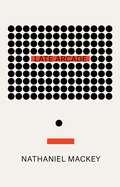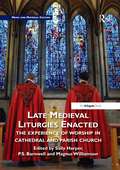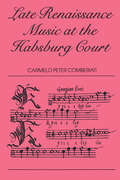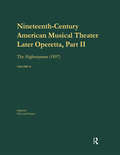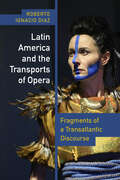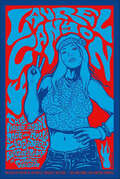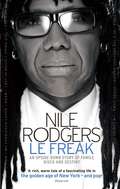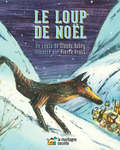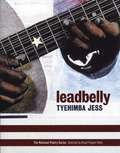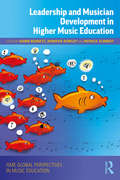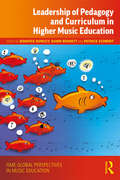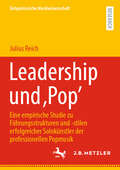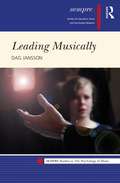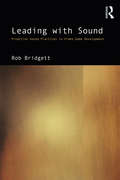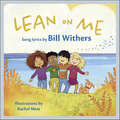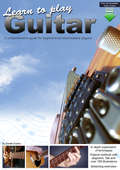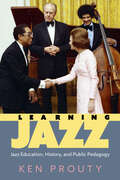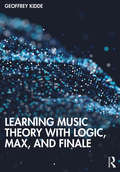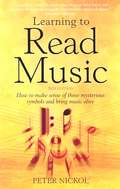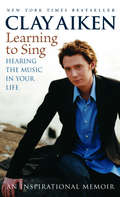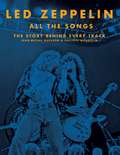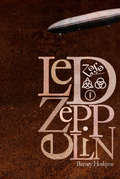- Table View
- List View
Late Arcade
by Nathaniel MackeyA new volume of the singular, ongoing, great American jazz novel Nathaniel Mackey’s Late Arcade opens in Los Angeles. A musician known only as N. writes the first of a series of letters to the enigmatic Angel of Dust. N.’s jazz sextet, Molimo m’Atet, has just rehearsed a new tune: the horn players read from The Egyptian Book of the Dead with lips clothespinned shut, while the rest of the band struts and saunters in a cosmic hymn to the sun god Ra. N. ends this breathless session by sending the Angel of Dust a cassette tape of their rehearsal. Over the next nine months, N.’s epistolary narration follows the musical goings-on of the ensemble. N. suffers from what he calls “cowrie shell at- tacks”—oil spills, N.’s memory of his mother’s melancholy musical Sundays— which all becomes the source of fresh artistic invention. Here is the newest installment of the National Book Award-winner Nathaniel Mackey’s From a Broken Bottle Traces of Perfume Still Emanate, the great American jazz novel of “exquisite rhythmic lyricism” (Bookforum).
Late Medieval Liturgies Enacted: The Experience of Worship in Cathedral and Parish Church (Music and Material Culture)
by Sally Harper, P.S. Barnwell and Magnus WilliamsonThis book critically explores ways in which our understanding of late medieval liturgy can be enhanced through present-day enactment. It is a direct outcome of a practice-led research project, led by Professor John Harper and undertaken at Bangor University between 2010 and 2013 in partnership with Salisbury Cathedral and St Fagans National History Museum, near Cardiff. The book seeks to address the complex of ritual, devotional, musical, physical and architectural elements that constitute medieval Latin liturgy, whose interaction can be so difficult to recover other than through practice. In contrast with previous studies of reconstructed liturgies, enactment was not the exclusive end-goal of the project; rather it has created a new set of data for interpretation and further enquiry. Though based on a foundation of historical, musicological, textual, architectural and archaeological research, new methods of investigation and interpretation are explored, tested and validated throughout. There is emphasis on practice-led investigation and making; the need for imagination and creativity; and the fact that enactment participants can only be of the present day. Discussion of the processes of preparation, analysis and interpretation of the enactments is complemented by contextual studies, with particular emphasis on the provision of music. A distinctive feature of the work is that it seeks to understand the experiences of different groups within the medieval church - the clergy, their assistants, the singers, and the laity - as they participated in different kinds of rituals in both a large cathedral and a small parish church. Some of the conclusions challenge interpretations of these experiences, which have been current since the Reformation. In addition, some consideration is given to the implications of understanding past liturgy for present-day worship.
Late Renaissance Music at the Hapsburg Court (Musicology)
by C. P. ComberiatiFirst Published in 1987. Routledge is an imprint of Taylor & Francis, an informa company.
Later Operetta 2: the Highwayman, Music by Reginald DeKoven, Libretto by Harry B. Smith, 1897 (Nineteenth-Century American Musical Theater Series)
by Reginald De KovenThe most successful American-born composer of operetta at the end of the nineteenth century was Reginald de Koven. The work reprinted in this volume, The Highwayman, is arguably his best work, although he is better known for the earlier Robin Hoodwixh its evergreen wedding ballad "Oh Promise Me." (Robin Hood is available as a reprint in the 1990 volume American Opera and Music for the Stage, in the G.K. Hall series Three Centuries of American Music.) The editor of this volume, Orly Leah Krasner, is a leading scholar of de Koven’s music. She teaches at the City University of New York, and her Ph.D. dissertation, "Reginald de Koven (1859-1920) and American Comic Opera at the Turn of the Century," is also from that university. Her introduction places the work in the tenor of contemporary critical reaction, and lists the sources available for further study. The Highwayman is one of the few complete operettas of its era for which we are fortunate enough to have original performing materials in the composer’s own hand. As the penultimate volume (number 15) in this series, de Koven’s work of 1897 contrasts with two works of the previous year, Walter Damrosch’s opera The Scarlet Letter (volume 16) and John Philip Sousa’s operetta El Capitan (volume 14).
Latin America and the Transports of Opera: Fragments of a Transatlantic Discourse (Performing Latin American and Caribbean Identities)
by Roberto Ignacio DíazLatin America and the Transports of Opera studies a series of episodes in the historical and textual convergence of a hallowed art form and a part of the world often regarded as peripheral. Perhaps unexpectedly, the archives of opera generate new arguments about several issues at the heart of the established discussion about Latin America: the allure of European cultural models; the ambivalence of exoticism; the claims of nationalism and cosmopolitanism; and, ultimately, the place of the region in the global circulation of the arts. Opera&’s transports concern literal and imagined journeys as well as the emotions that its stories and sounds trigger as they travel back and forth between Europe—the United States, too—and Latin America. Focusing mostly on librettos and other literary forms, this book analyzes Calderón de la Barca&’s baroque play on the myth of Venus and Adonis, set to music by a Spanish composer at Lima&’s viceregal court; Alejo Carpentier&’s neobaroque novella on Vivaldi&’s opera about Moctezuma; the entanglements of opera with class, gender, and ethnicity throughout Cuban history; music dramas about enslaved persons by Carlos Gomes and Hans Werner Henze, staged in Rio de Janeiro and Copenhagen; the uses of Latin American poetry and magical realism in works by John Adams and Daniel Catán; and a novel by Manuel Mujica Lainez set in Buenos Aires&’s Teatro Colón, plus a chamber opera about Victoria Ocampo with a libretto by Beatriz Sarlo. Close readings of these texts underscore the import and meanings of opera in Latin American cultural history.
Laughter In The Dark: Egypt To The Tune Of Change
by Yasmine El RashidiA decade ago, millions of Egyptians took to the streets in a people-led revolution that captivated the world’s attention and sent ripples across the Middle East. But the so-called “Arab Spring” quickly faded, and a return to the status quo—of authoritarian rule—was cemented. What happened to the energy and desire for change? In Egypt, the answer lies in its youth, who comprise the bulk of the country’s fast-growing 106 million citizens. Sixty percent of the population is under the age of twenty-five, and their world views are very much influenced by social media: TikTok is their primary language and medium of choice. Music is their means of expression—in particular, a thriving hip-hop scene known as mahraganat. This music has given voice to deep dissatisfaction with the Egyptian state and the overall conditions of Egyptian society and culture. Could this be the start of a force for change? Laughter in the Dark is a riveting portrait of a country that is being transformed, for good or bad, by the rise of a fresh youth culture.
Laurel Canyon: The Inside Story of Rock-and-Roll's Legendary Neighborhood
by Michael WalkerA “richly anecdotal” account of the secluded LA neighborhood’s legendary music scene, a tale of groupies, cocaine, and California dreaming (Salon).Finalist, SCBA Book Award for NonfictionA Los Angeles Times BestsellerIn the late sixties and early seventies, an impromptu collection of musicians colonized a eucalyptus-scented canyon deep in the Hollywood Hills of Los Angeles and melded folk, rock, and savvy American pop into a sound that conquered the world as thoroughly as the songs of the Beatles and the Rolling Stones had before them. Decades later, the music made in Laurel Canyon continues to pour from radios, earbuds, and concert stages around the world.In Laurel Canyon, veteran journalist Michael Walker draws on interviews with those who were there to tell the inside story of this unprecedented gathering of some of the era’s leading musical lights—including Joni Mitchell; Jim Morrison; Crosby, Stills, and Nash; John Mayall; the Mamas and the Papas; Carole King; the Eagles; and Frank Zappa, to name just a few—who turned Los Angeles into the music capital of the world and forever changed the way popular music is recorded, marketed, and consumed.“An exhaustively researched and richly anecdotal book that will fascinate both rock aficionados and cultural historians.” —Salon“Captures all the magic and lyricism of an almost mythological geographical spot in the history of pop music . . . the story of a more melodious time in rock and roll where the great talents of the ‘60s and ‘70s cloistered together in a sort of enchanted valley populated by an all-star cast of characters.” —Steven Gaines, author of Philistines at the Hedgerow
Le Freak: An Upside Down Story of Family, Disco and Destiny
by Nile RodgersYou will hear a Nile Rodgers song today. It will make you happy. Legendary producer and co-founder of Chic, Nile wrote 'We are Family' for Sister Sledge and 'I'm Coming Out' for Diana Ross, and then produced Let's Dance for David Bowie and Like a Virgin for Madonna. But before he reinvented pop music Nile Rodgers invented himself. Le Freak is an astonishing, exuberant and inspiring story of a creative genius. It is also a stunning recreation of a time and place - by the man who wrote its soundtrack.
Le Jazz: Jazz and French Cultural Identity
by Matthew F. JordanIn Le Jazz, Matthew F. Jordan deftly blends textual analysis, critical theory, and cultural history in a wide-ranging and highly readable account of how jazz progressed from a foreign cultural innovation met with resistance by French traditionalists to a naturalized component of the country's identity. Jordan draws on sources including ephemeral critical writing in the press and twentieth-century French literature to trace the country's reception of jazz, from the Cakewalk dance craze and the music's significance as a harbinger of cultural recovery after World War II to its place within French ethnography and cultural hybridity. Countering the histories of jazz's celebratory reception in France, Jordan delves in to the reluctance of many French citizens to accept jazz with the same enthusiasm as the liberal humanists and cosmopolitan crowds of the 1930s. Jordan argues that some listeners and critics perceived jazz as a threat to traditional French culture, and only as France modernized its identity did jazz become compatible with notions of Frenchness. Le Jazz speaks to the power of enlivened debate about popular culture, art, and expression as the means for constructing a vibrant cultural identity, revealing crucial keys to understanding how the French have come to see themselves in the postwar world.
Le loup de Noël
by Claude AubryMaÎtre Griboux, un vieux loup des Laurentides, maussade et solitaire, n'a plus rien À manger. AffamÉ, il descend au village la veille de NoËl oÙ il est attirÉ par la chaleur et les lumiÈres de l'Église. Il entre durant la messe de minuit et voit un enfant, tout potelÉ, couchÉ dans une crÈche. Perdant toute prudence, il se prÉcipite pour le dÉvorer devant une assemblÉe paralysÉe d'Étonnement. Heureusement, le curÉ intervient pour Épargner l'animal qui deviendra l'ami des enfants.
Leadbelly
by Tyehimba Jess"It is exhilarating to be invited into a world so large and muscular, so rooted in history, a world where so much is at stake. "--Brigit Pegeen Kelly, National Poetry Series judge A biography in poems, leadbelly examines the life and times of the legendary blues musician from a variety of intimate perspectives and using a range of innovative poetic forms. A collage of song, culture, and circumstance, alive and speaking. Tyehimba Jess' numerous awards include fellowships from the NEA and the Fine Arts Work Center in Provincetown. A native of Detroit, he is a proud alumnus of the Chicago Green Mill Slam teams and Cave Canem. His first nonfiction book isAfrican American Pride: Celebrating our Achievements, Contributions, and Enduring Legacy (Citadel Press, 2003).
Leadership and Musician Development in Higher Music Education (ISME Global Perspectives in Music Education Series)
by Patrick Schmidt Dawn Bennett Jennifer RowleyLeadership and Musician Development in Higher Music Education informs, challenges and evaluates the central practices, policies and theories that underpin the preparation of future music leaders and the leadership of music in higher education. In higher education, it is often presumed that preparing for professional work is the responsibility of the individual rather than the institution. This anthology draws on the expertise of music practitioners to present the complexities surrounding this topic, exploring approaches to leadership development while addressing prevalent leadership issues from multiple standpoints. Leadership is an inherent part of being a musician: from the creative act through to collaborative engagement, it is fundamental to creating and sustaining a career in music. To expect musicians to develop these necessary skills "on the job", however, is unreasonable and impractical. What support might be given to those looking to negotiate a career as a musician? In fourteen essays, contributors from around the globe explore this question and more, questions such as: How might leadership be modelled for aspiring musicians? How might students learn to recognise, appraise and extend their leadership development? How might institutional leaders challenge curricular and pedagogical norms? Effective leadership development for musicians is vital to the longevity of the profession – Leadership and Musician Development in Higher Music Education is a likewise vital resource for students, educators and future music leaders alike.
Leadership of Pedagogy and Curriculum in Higher Music Education (ISME Global Perspectives in Music Education Series)
by Patrick Schmidt Dawn Bennett Jennifer RowleyLeadership of Pedagogy and Curriculum in Higher Music Education is the second of a two-volume anthology dedicated to leadership and leadership development in higher music education. Fifteen authors write from multiple countries and contexts, exploring pedagogical and curricular leadership challenges and successes from around the globe. They draw attention to the dynamics of pedagogical approaches which encourage learners’ deep and agentic engagement, considering the sustainability and scope of such interventions while highlighting positive frameworks and approaches. As with its companion volume, Leadership of Pedagogy and Curriculum in Higher Music Education includes student commentary in which student contributors give concrete ideas and recommendations for facilitating and strengthening leadership development through practical and equitable strategies with students, communities and colleagues. The outcome is a collection of essays designed to offer student musicians, higher education teachers and institutional leaders theoretically informed and practical insights into the development and practice of leadership.
Leadership und ‚Pop’: Eine empirische Studie zu Führungsstrukturen und -stilen erfolgreicher Solokünstler der professionellen Popmusik (Zeitgenössische Musikwissenschaft)
by Julius ReichDie Monographie hat sich zum Ziel gesetzt, das Phänomen des Leaderships als Erfolgsfaktor am Beispiel erfolgreicher Künstler der professionellen Popularmusik zu untersuchen. Sie ist sowohl ein Handbuch für Interessierte, als auch eine wissenschaftliche Studie und besteht aus thematischen Kapiteln, sowie Interviewstudien – mit relevanten Experten der Musikbranche und mit erfolgreichen Künstlern (anonymisiert) aktueller deutschsprachiger Popularmusik.In diesem Werk werden die aktuellen Entwicklungen der Musikbranche dargestellt und der Nachweis gefestigter Machtpositionen etablierter und neuer Gatekeeper erbracht. Zudem wird ein Kompetenzprofil für Leadership in der Popularmusik entwickelt. Ferner konnte die in der bisherigen Forschung postulierte ‚Künstlerpersönlichkeit‘ empirisch bestätigt werden. Zentral ist der Nachweis eines einzigartigen Führungsstiles (Laissez-Faire und zugleich transformational) der Künstler. Zusammenfassend wird aufgezeigt, dass das Leadership von Solokünstlern der Popularmusik keinem bisherigen Konzept der Führungsforschung entspricht und sich als den Besonderheiten kreativ-künstlerischer Leistungserzeugung angepasstes Konzept darstellt.
Leading Musically: Power And Senses In Concert (SEMPRE Studies in The Psychology of Music)
by Dag JanssonMusical leadership is associated with a specific profession—the conductor—as well as being a colloquial metaphor for human communication and cooperation at its best. This book examines what musical leadership is, by delving into the choral conductor role, what goes on in the music-making moment and what it takes to do it well. One of the unique features of the musical ensemble is the simultaneity of collective discipline and individual expression. Music is therefore a potent laboratory for understanding the leadership act in the space between leader and team. The musical experience is used to shed light on leading and following more broadly, by linking it to themes such as authority, control, empowerment, intersubjectivity, sensemaking and charisma. Jansson develops the argument that musical leadership involves the combination of strong power and deep sensitivity, a blend that might be equally valid in other leadership domains. Aesthetic knowledge and musical perception therefore offer untapped potential for leadership and organisational development outside the art domain.
Leading with Sound: Proactive Sound Practices in Video Game Development
by Rob BridgettLeading with Sound is the must-have companion guide to working on video game projects. Focused on the creative, collaborative, philosophical and organizational skills behind game sound and eschewing the technical, this book celebrates the subjects most essential to leading with sound in video game development at any level. Refuting the traditional optics of sound as a service in favour of sound as a pro-active visionary department, , this book examines each of the four food-groups of dialogue, sound design, music and mix, not through the usual technical and production lenses of ‘how’ and ‘when’, but the essential lens of ‘why’ that enables leadership with sound. Leading with Sound is essential reading for aspiring sound designers, inside and outside of the classroom, as well as experienced professionals in the game industry.
Lean on Me: ` (LyricPop #0)
by Bill WithersBill Withers's classic anthem to friendship lives on in this moving children's picture book adaptation."Lean on me When you’re not strong And I’ll be your friend I’ll help you carry on . . ." Lean on Me is an endearing children's picture book that beautifully demonstrates the power of friendship, based on Bill Withers's classic song of the same name. “Lean on Me” appeared on Withers's 1972 album Still Bill. The song reached #1 on the Billboard Hot 100 chart and ranked #208 on Rolling Stone's "500 Greatest Songs of All Time" list. With Withers's lyrics and illustrations by Rachel Moss, this picture book follows four close friends through the stages of their childhood, from elementary school until their high school graduation. Withers’s classic and loving refrain serenades them as they lean arm-in-arm into adulthood.
Learn to Play Guitar: A Comprehensive Guitar Guide for Beginners to Intermediate Players
by Gareth Evans“Covers a wide range topics essential for all guitarists. Plenty of information and solid advice that a player can dip into as needed. There are many examples to practice with the backing tracks. A very useful tool to help you progress with your guitar playing." Hedley Timbs BA(Mus), Grad.Dip. Teaching (New Zealand) Learn to Play Guitar is comprehensive and clear with over 180 photographic examples, illustrations and purpose made diagrams. This guitar book includes 42 downloadable mp3 tracks of full band demo and backing track with the guitar removed for you to play over. Learn to Play Guitar bridges the gaps, explaining guitar techniques that can be taken for granted by more experienced guitar players.Melodies - To get you straight into playing music, numbers have been added underneath guitar tablature to assist with the rhythm. Later on, the rhythmical aspect of conventional music notation is covered so you can use it in conjunction with tablature.Rhythm Guitar - Changing between chords and strumming are presented as separate subjects initially, so that you can develop coordination in each hand independently. They are then brought together starting with basic exercises, getting more advanced until there is a rhythm guitar musical piece to play.Music Theory - The major scale, minor scale, major and minor pentatonic scales and basic major and minor chord construction are explained in terms of the fret-board and reinforced by musical pieces in various styles to make the learning process practical and enjoyable.What Else? - Fret-board layout, power chords, barre chords, how to string a guitar, how to practise guitar, palm muting and basic lead guitar techniques.Please Note: The eBook includes musical pieces so is not suitable for smaller screens. "We loved the book. The information was well paced and concise enough not to overwhelm. Any beginner would definitely benefit from having this book, and it's a great reminder for those who might have forgotten details or are looking for them.” Nimal De Silva, The Music Garage (Singapore)"Plenty of detail that goes into posture, hand position, thumb position, etc. The notation and strumming is really good here because it builds up in stages. In a lesson, you can introduce it in this way piece by piece and not overwhelm the student." Michael Hanna, Grade 8 RS.Guitar - Larne Guitar School (N.Ireland)
Learning Jazz: Jazz Education, History, and Public Pedagogy (American Made Music Series)
by Ken ProutyLearning Jazz: Jazz Education, History, and Public Pedagogy addresses a debate that has consumed practitioners and advocates since the music's early days. Studies on jazz learning typically focus on one of two methods: institutional education or the kinds of informal mentoring relationships long associated with the tradition. Ken Prouty argues that this distinction works against a common identity for audiences and communities. Rather, what happens within the institution impacts—and is impacted by—events and practices outside institutional contexts.While formal institutions are well-defined in educational and civic contexts, informal institutions have profoundly influenced the development of jazz and its discourses. Drawing on historical case studies, Prouty details significant moments in jazz history. He examines the ways that early method books capitalized on a new commercial market, commandeering public expertise about the music. Chapters also discuss critic Paul Eduard Miller and his attempts to develop a jazz canon, as well as the disconnect between the spotlighted “great men” and the everyday realities of artists. Tackling race in jazz education, Prouty explores the intersections between identity and assessment; bandleaders Stan Kenton and Maynard Ferguson; public school segregation; Jazz at Lincoln Center; and more. He further examines jazz’s “public pedagogy,” and the sometimes-difficult relationships between “jazz people” and the general public. Ultimately, Learning Jazz posits that there is room for both institutional and noninstitutional forces in the educational realm of jazz.
Learning Music Theory with Logic, Max, and Finale
by Geoffrey KiddeLearning Music Theory with Logic, Max, and Finale is a groundbreaking resource that bridges the gap between music theory teaching and the world of music software programs. Focusing on three key programs—the Digital Audio Workstation (DAW) Logic, the Audio Programming Language (APL) Max, and the music-printing program Finale—this book shows how they can be used together to learn music theory. It provides an introduction to core music theory concepts and shows how to develop programming skills alongside music theory skills. Software tools form an essential part of the modern musical environment; laptop musicians today can harness incredibly powerful tools to create, record, and manipulate sounds. Yet these programs on their own don’t provide musicians with an understanding of music notation and structures, while traditional music theory teaching doesn’t fully engage with technological capabilities. With clear and practical applications, this book demonstrates how to use DAWs, APLs, and music-printing programs to create interactive resources for learning the mechanics behind how music works. Offering an innovative approach to the learning and teaching of music theory in the context of diverse musical genres, this volume provides game-changing ideas for educators, practicing musicians, and students of music. The author's website at http://www.geoffreykidde.com includes downloadable apps that support this book.
Learning To Read Music 3rd Edition: How To Make Sense Of Those Mysterious Symbols And Bring Music Alive
by Peter NickolWhether you want to learn how to play an instrument, or just refresh your existing capability, whether you sing in a choir, or would simply like to follow scores while listening, this book will help you achieve your aim. It leads you carefully through the basics of pitch, rhythm, keys, scales, chords, and much more, building your knowledge chapter by chapter until you are able to read music with ease. The visual index of musical symbols laid out at the start will make clear the task at hand.Reference to common instruments and familiar tunes will help bring your learning to life, while self-testing and chapter summaries ensure that you develop and retain this new skill. By the end of the book, you will have come a long way. Your knowledge of music notation will be a pleasure to you, and a useful tool. As well as its practical applications for any performer, this book will give you insights into how music is put together. You will have the feeling of knowing the music from the inside out.
Learning To Read Music 3rd Edition: How to make sense of those mysterious symbols and bring music alive
by Peter NickolWhether you want to learn how to play an instrument, or just refresh your existing capability, whether you sing in a choir, or would simply like to follow scores while listening, this book will help you achieve your aim. It leads you carefully through the basics of pitch, rhythm, keys, scales, chords, and much more, building your knowledge chapter by chapter until you are able to read music with ease. The visual index of musical symbols laid out at the start will make clear the task at hand.Reference to common instruments and familiar tunes will help bring your learning to life, while self-testing and chapter summaries ensure that you develop and retain this new skill. By the end of the book, you will have come a long way. Your knowledge of music notation will be a pleasure to you, and a useful tool. As well as its practical applications for any performer, this book will give you insights into how music is put together. You will have the feeling of knowing the music from the inside out.
Learning to Sing: Hearing the Music in Your Life: An Inspirational Memoir
by Clay AikenIn Learning to Sing, Clay Aiken tells the story of how his faith was integral to him learning valuable life lessons during his meteoric rise from life as an aspiring educator in Raleigh, North Carolina to instant stardom on "American Idol. " Clay's advice is 1) Believe in yourself, 2) Believe in God, and 3) Be really stubborn. This personal relationship with God is key to personal success, as Clay has witnessed in real life experiences. When asked to "dirty up" his lyrics to increase sales, he resisted -- and has sold more than 3 million albums. He refuses to make videos placing him in inappropriate situations, and considers his relationship with God the most valuable in his life. Learning to Sing is an account of Clay Aiken's extraordinary faith and will and perseverance, and an inspiring memoir by someone who became -- against all odds -- one of the biggest pop stars of his time.
Led Zeppelin All the Songs: The Story Behind Every Track (All The Songs Ser.)
by Jean-Michel Guesdon Philippe MargotinTake a deep dive into the innovative recording history of Led Zeppelin, in this newest addition to the fan-favorite All the Songs series.Fifty years after their first practice in a Soho basement, Led Zeppelin continues to fascinate new generations of listeners. While their legendary back-stage debauchery has been written about extensively in other books, All the Songs is all about the music, detailing the studio magic and inspiration that made all nine albums go platinum, including Led Zeppelin IV which was certified x23 platinum and has sold more than 37 million copies worldwide. Studio stories will include their productive time at Headley Grange in Wales, a poorly-heated former poorhouse where they recorded parts of Led Zeppelin III, Led Zeppelin IV, Houses of the Holy and Physical Graffiti. And how the first album was recorded in three weeks but their second took six months, done while the band was on a world tour. They carried the masters of the recording session in a steamer trunk wherever they went. Out of these chaotic sessions came the "Whole Lotta Love," which was finished in New York with Hendrix engineer Eddie Kramer helping create the psychedelic middle part, as well as "The Lemon Song," which was cut live in the studio. Page worked feverishly with Kramer to mix the LP on a primitive 12-channel Altec board in a two-day span. Fans will also learn the genesis of their lyrics, the inspiration for their album covers, the instruments used, and the contributions of engineers such as Andy Johns, who helped create the iconic drum sound on "When the Levee Breaks" by recording Bonham at the bottom of a stairwell.
Led Zeppelin IV (Rock Of Ages Ser.)
by Barney HoskynsLed Zeppelin IV, often called heavy metal's greatest album, kicks off an exciting new series that takes a fresh, in-depth look at some of the greatest works from the most influential artists of the rock era. Fans may know the songs, but wait until they hear the stories behind them!The music contained in Led Zeppelin IV is part of the soundtrack to a generation. Released in 1971, it rocks, stomps, glides, and shimmers as it covers all the bases the band had mastered: heavy blues, barroom rock and roll, mandolin-driven folk, epic Tolkien-infused mysticism, acoustic Americana, and more. Certified gold one week after its release, the album went to #2 on the U.S. charts and #1 in the U.K. It remained on U.S. charts for 259 weeks. There probably isn't an aspiring rock guitarist anywhere who hasn't plucked out the notes and chords to "Stairway to Heaven" or "Black Dog," and yet many music lovers are unaware of the intriguing backstory to this genre-defining work.To this day there is confusion about what is the actual title of the album. And what about those mysterious symbols? Barney Hoskyns pierces those veils and more as he tells the fascinating story of the evocative set that cemented Led Zeppelin's standing as the biggest, baddest, loudest band in the world—and that remains today the apex of their art.
